The effects of free fatty acids on gluconeogenesis and glycogenolysis in normal subjects
- PMID: 9927497
- PMCID: PMC407905
- DOI: 10.1172/JCI5479
The effects of free fatty acids on gluconeogenesis and glycogenolysis in normal subjects
Abstract
We have quantitatively determined gluconeogenesis (GNG) from all precursors, using a novel method employing 2H20 to address the question of whether changes in plasma free fatty acids (FFA) affect GNG in healthy, nonobese subjects. In the first study (n = 6), plasma FFA were lowered at 16 to 20 hours with nicotinic acid (NA) and were then allowed to rise at 20 to 24 hours (FFA rebound after administration of NA). FFA decreased from 387 microM at 16 hours to 43 microM at 20 hours, and then rebounded to 1,823 microM at 24 hours. GNG decreased from 58.1% at 16 hours to 38.6% of endogenous glucose production at 20 hours (P < 0.005) and then rebounded to 78. 9% at 24 hours (P < 0.05). Conversely, glycogenolysis (GL) increased from 41.9% at 16 hours to 61.4% at 20 hours (P < 0.05), and then decreased to 21.1% at 24 hours (P < 0.05). In the second study (controls; n = 6), volunteers were analyzed between 16 and 24 hours after the last meal. FFA rose from 423 to 681 microM (P < 0.05), and GNG from 50.3% to 61.7% (P < 0.02), whereas GL decreased from 49.7% to 38.3% (P < 0.05). Endogenous glucose production decreased at the same rate in both studies, from 10.7 to 8.6 micromol/kg/min (P < 0. 05). In study 3 (n = 6), in which the NA-mediated decrease of plasma FFA was prevented by infusion of lipid and heparin, neither FFA nor GNG changed significantly. In summary, our data suggest that (a) acute changes in plasma FFA produce acute changes in GNG and reciprocal changes in GL; (b) the decrease in EGP between 16 and 24 hours of fasting is due to a fall in GL; and (c) NA has no direct effect on GNG.
Figures
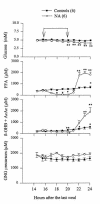


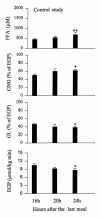
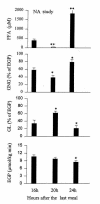
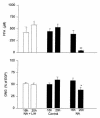
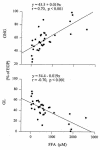
References
-
- Cahill GF., Jr Starvation in man. N Engl J Med. 1970;282:668–675. - PubMed
-
- Gonzalez-Manchon C, Ayuso M, Parrilla R. Control of hepatic gluconeo-genesis: role of fatty acid oxidation. Arch Biochem Biophys. 1989;271:1–9. - PubMed
-
- Morand C, Remesy C, Demigne C. Fatty acids are potent modulators of lactate utilization in isolated hepatocytes from fed rats. Am J Physiol. 1993;264:E816–E823. - PubMed
-
- Arinze I, Hanson R. Mitochondrial redox state and the regulation of gluconeo-genesis in the isolated, perfused cat liver. FEBS Lett. 1973;31:280–282. - PubMed

